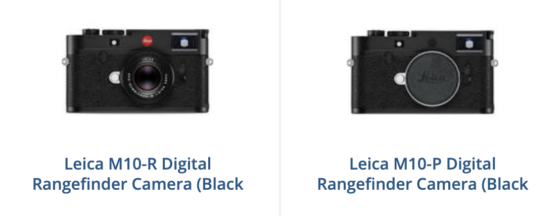Leica M10-R vs Leica M10-P shadow and highlight recovery side-by-side comparison
By Onasj (see previous articles by Onansj)
I obtained a customer-release—not pre-release/beta—M10-R and compared it side-by-side with the M10-P on a test scene. The firmware version for both was the latest firmware currently available to the public: 10.20.27.20 for the M10-R (upgraded from the initial released 10.20.23.49 firmware that was pre-installed in the new camera), and 2.7.5.0 for the M10-P.
Methodology: all shots were taken on a tripod with a 2-second delay to minimize vibration. The same Leica 50 APO lens was used for all tests. The aperture was set to f/5.6 for all tests. The ISO value was 100 for all tests. To the best of my ability, the M10-P and the M10-R were treated equally. The test shots were taken in one sitting, with the same tripod position ~1.3 m from the target, and under the same lighting. The images were focused by rangefinder and confirmed by live view for each camera.
For the “normal exposure” test shots, a 2-second shutter speed was used. For the “-4 EV” underexposure shots, the camera was set to -3 EV exposure compensation, then the camera’s chosen shutter speed was halved to reach -4 EV. For the “+3 EV” overexposure shots, the camera was set to +3 EV exposure compensation. This same methodology was applied to both the M10-P and the M10-R cameras. I did not simply use math to calculate underexposure and overexposure shutter times because doing so resulted in somewhat more different actual exposure levels in the resulting pictures between the M10-P vs. the M10-R than when I allowed the camera to find the shutter speed required to achieve under- or over-exposure, meaning that the effective transmission value and/or metering is slightly different between the two cameras even though both were set to multi-field metering. Using the above method resulted in the underexposed photos to be of similar overall exposure between the two cameras, and the overexposed photos to also be of similar overall exposure. In general, the M10-R images were approximately +0.25 EV brighter at the same shutter speed than the M10-P images.
All the test shots were recorded as DNG files, then transferred and opened in Adobe Photoshop 2020 with Camera Raw 12.3 (which has native M10-R support). To test shadow recovery and highlight recovery, in Adobe Camera Raw I did my best to match the overall exposure and color of the “normal exposure” shot, using only the exposure, color temperature, and tint sliders. To preserve all the information in both cameras’ files, I scaled the resulting M10-P shots up to 7864 pixels wide.
Shown below are crops of the resulting files at 25% magnification:

Finding #1: For shadow recovery from underexposed DNG files at ISO 100, both the M10-P and the M10-R are superb.
Indeed, there is virtually no detectable difference between the “normal exposure” shots and the -4 EV shots after pushing exposure by +4 EV and doing some simple color correction.
Finding #2: For highlight recovery from overexposed DNG files at ISO 100, the M10-R substantially outperforms the M10-P.
Consistent with the reviews of Jono Slack and others, highlight recovery of the M10-R is much improved over the very modest highlight recovery of the M10-P. The sky in the cards is much less blown out by the M10-R, the skin between the eyebrow and eye on the left is much less blown out, and the black-to-white gradient stripe on the left loses much less distance before reaching full white in the M10-R highlight recovery photo than the M10-P’s photo—even though the M10-R starts out 0.25 EV more exposed than the M10-P (which is also visible in the gradient stripe).
Since the M10-P is said to offer better highlight preservation at ISO 200 than at ISO 100 (supposedly this is why auto-ISO in the current M10/M10-P firmware uses ISO 200 rather than ISO 100 when possible), I repeated the above highlight recovery test at ISO 200. As before, the cameras chose slightly different shutter speeds to achieve similar overall normal exposures and +3 EV overexposures. The M10-R continues to be more light-sensitive than the M10-P; the “normal exposure” chosen by the camera in this case at ISO 200 was 0.5 s for the M10-R and 1.0 s for the M10-P, resulting in similar exposure levels, but a bit less exposed than the ISO 100 test. In other words, it is not really valid to compare images between the ISO 200 and the ISO 100 test, although comparisons within the ISO 200 test should be valid. Here are the results:

Finding #3: The improved highlight recovery offered by the M10-R compared with the M10-P also applies at ISO 200.
Even though this test doesn’t push either camera as hard as the ISO 100 test due to a lower overall exposure level, once again the M10-R offers better highlight recovery than the M10-P; indeed, only a little of the +3 EV M10-R image is lost after -3 EV correction in post, whereas more parts of the face at the left, more of the gradient bar, and more of the sky on the right remain blown out by the M10-P.
Overall, the M10-R offers similar outstanding shadow recovery as the M10-P, but a marked improvement in highlight recovery, at least under these test conditions at ISO 100 and at ISO 200.
Related posts:
Leica M10-R vs Leica M10 Monochrom high-ISO acuity and noise side-by-side comparison
Leica M10 vs. Leica M10P vs. Leica M10M vs. Leica M10R specifications comparison
















